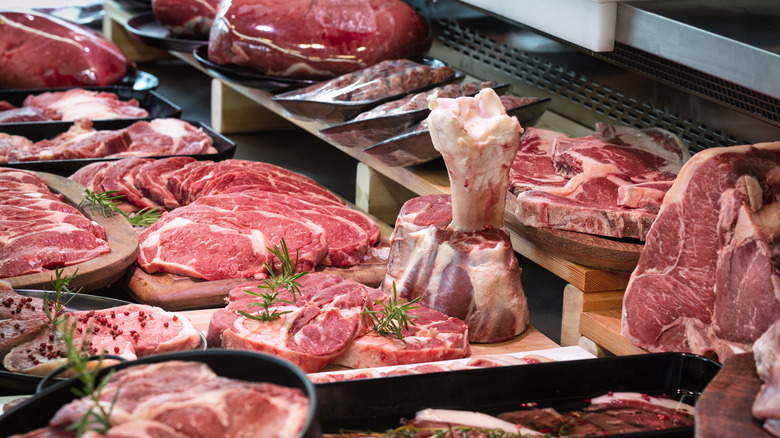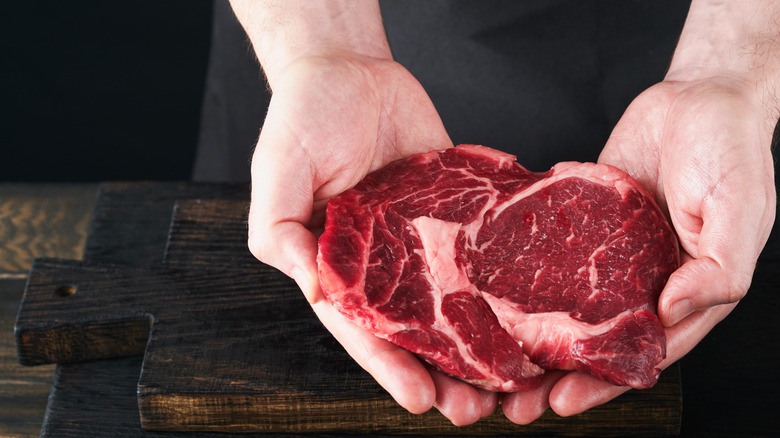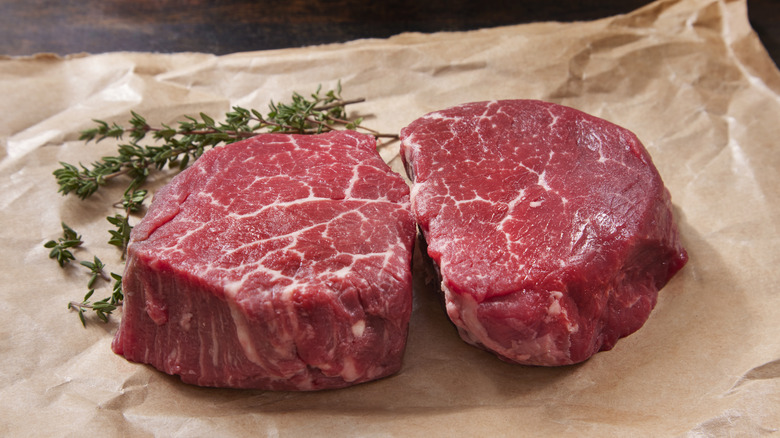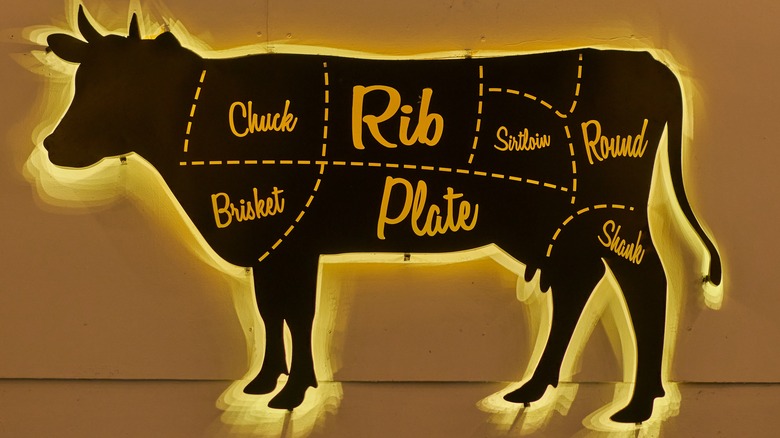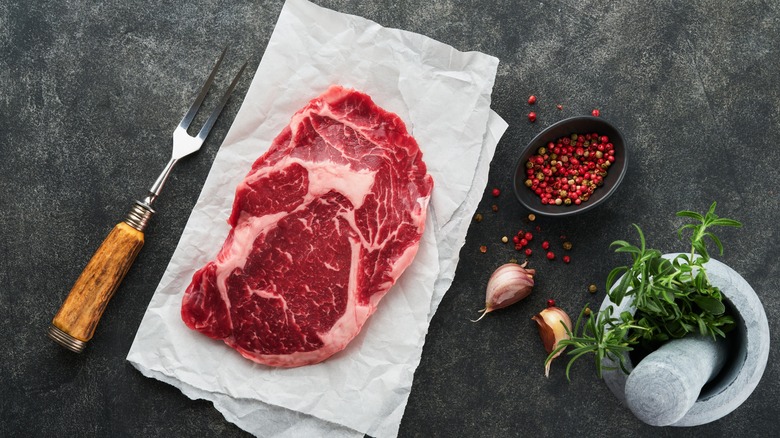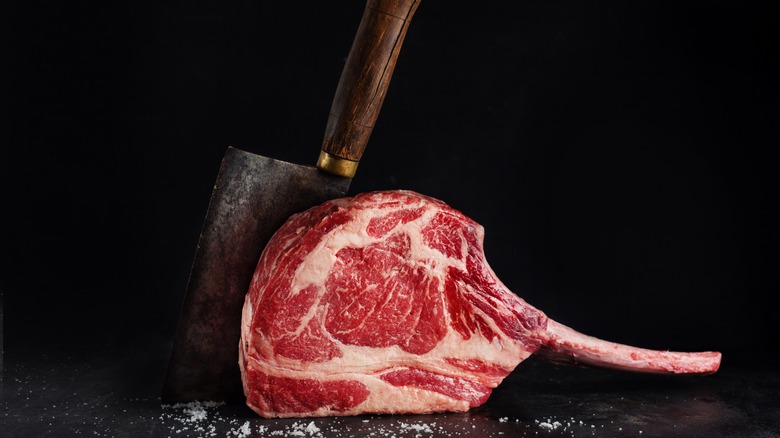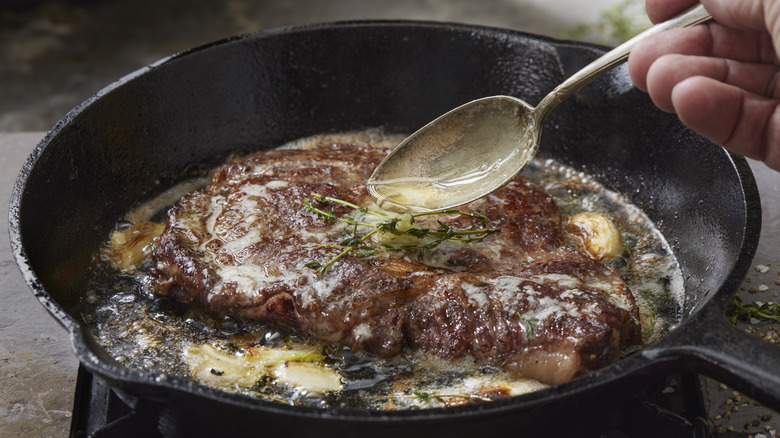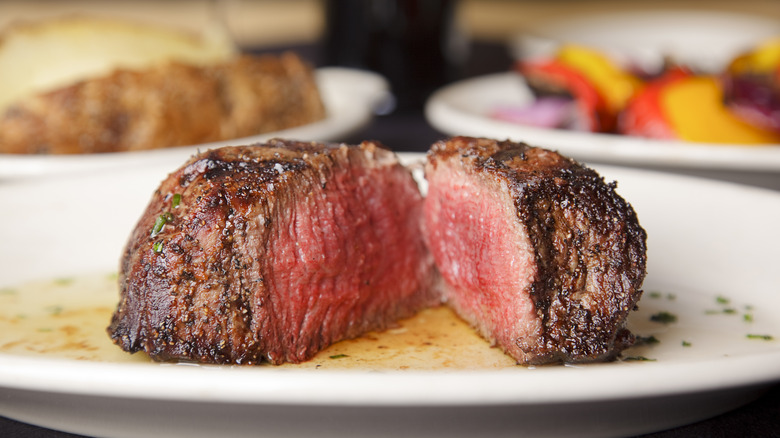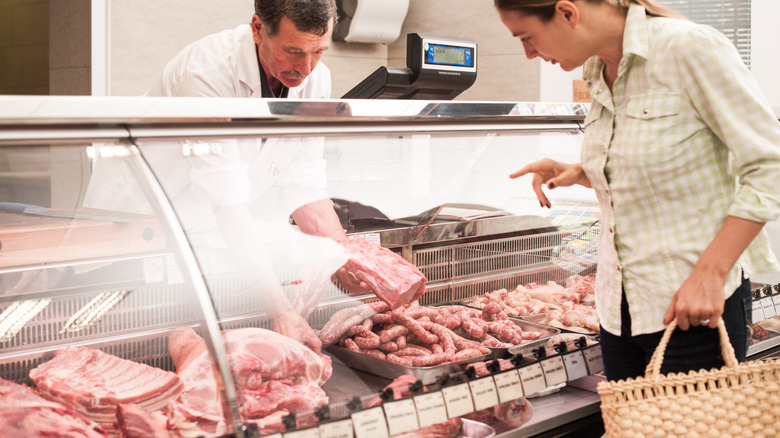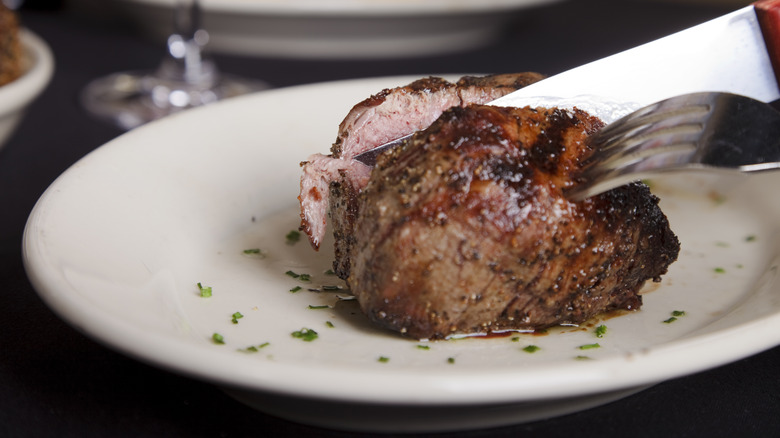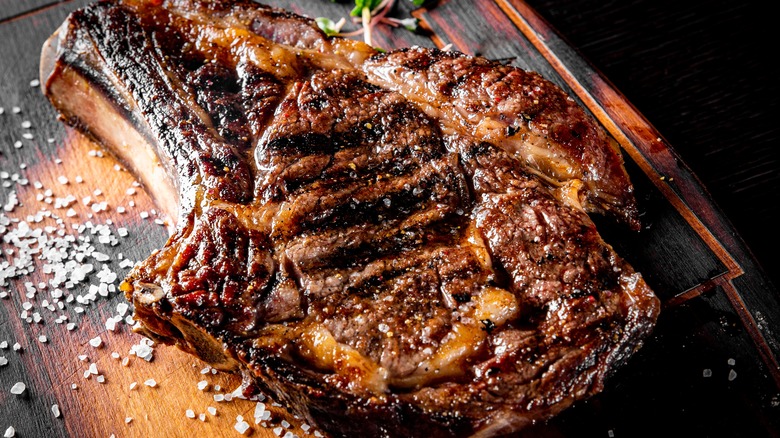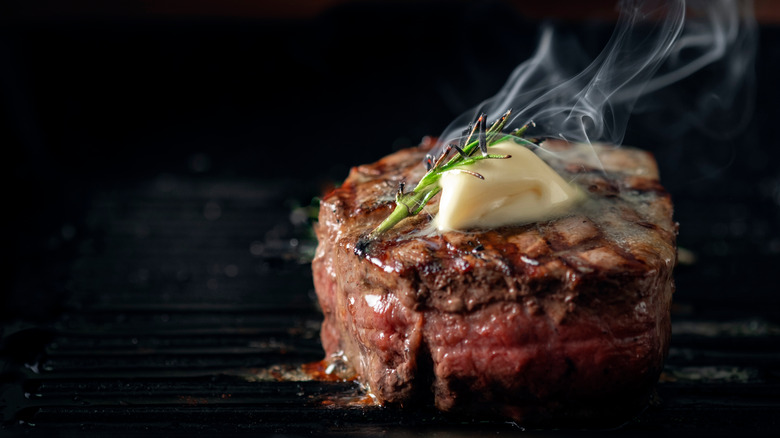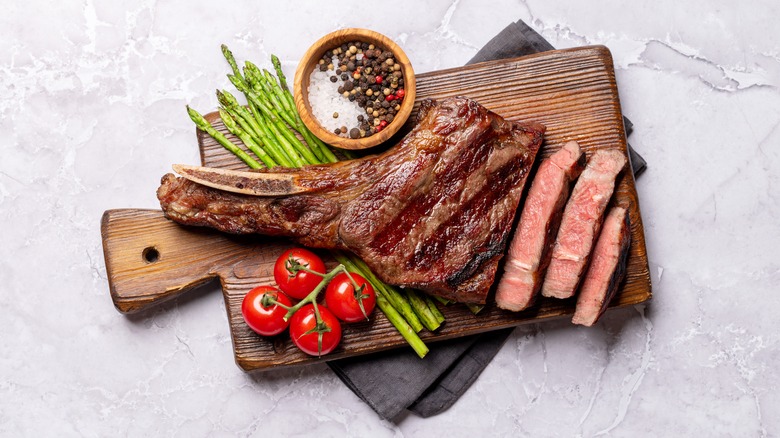Filet Mignon Vs Ribeye: Everything You Need To Know
Lovers of steak have loads of choice cuts to choose from, from New York strip to flank. Each steak will have its own characteristics when it comes to flavor, texture, and even nutritional value, and all of this depends on where on the cow it comes from. As a rule of thumb, harder-working muscles will tend to be tougher in texture and require low, slow cooking to bring out their rich flavor — think cuts like brisket or shoulder, which love being stewed or smoked. Muscles that do a bit of work but not quite as much as legs or shoulders will tend to be marbled but still tender, while the muscles that do the least work will be the tenderest and leanest of them all. It's these two middle categories that prove to be the best when it comes to steak, but even within this narrower window, variety awaits the discerning steak eater.
Ribeye and filet mignon are two of the choicest cuts, conquering the hearts of beef lovers the world over. But despite both being beloved, the reality is that these cuts couldn't be more different from one another. Here's everything you need to know to pick the one best suited to your tastes.
What is a ribeye?
Ribeye's very name gives you your first essential hint regarding this sought-after cut. Hailing from the rib section (and more specifically from between the 6th and 12th rib on the cow), the ribeye is known for having a rich, marbled texture and loads of beefy, buttery notes. It's no surprise it's a favorite among pros, who love it for its balance of tenderness and fat, and above all for its rich flavor.
Ribeye is also occasionally marketed with other names, including Delmonico steak, Scotch fillet, market steak, Spencer steak, Saratoga steak, or beauty steak. The ribeye is actually made up of three separate muscles, of which the central "eye" is the most coveted. You'll occasionally see this steak sold on its own, marketed as the eye of ribeye. You'll also find bone-in ribeyes, some of which have a long, protruding bone you can grasp; this latter cut is called a tomahawk steak.
What is a filet mignon?
Filet mignon is a small steak taken from the narrowest end of the tenderloin, which runs along the back of the cow. This placement is what gives it its name, which comes from the French for "delicate" or "dainty" filet. Filet mignon is above all prized for its leanness and its tenderness. Indeed, not only is filet mignon lower in fat than many other premium cuts, but when perfectly cooked, it barely needs a knife.
Filet mignon is similar to a tenderloin steak or chateaubriand steak, both of which come from the fatter part of the same muscle. Some American butchers may market filet mignon under other names, such as tenderloin filet or tournedos, which is usually cut into a round, very thick steak. Sometimes, a tournedos will be wrapped in bacon fat or beef fat, which makes this lean cut all the more luscious when you cook it.
Ribeye comes from the rib, while filet mignon comes from the loin
Most of the essential differences between ribeye and filet mignon come from where they are cut from the cow, so it seems apt to begin the comparison there. Taken from the rib section of the cow, aptly-named ribeye gets its amazing texture and flavor from the unique way in which this muscle is used. While not actively involved in the movement, the ribeye is essential for supporting the cow's consequential weight, an average of 1,400 pounds. Supporting the ruminant as it grazes means that this muscle develops loads of intramuscular marbling without the toughness of muscles that do more active work, like the shank, which keeps the cow moving.
Filet mignon, meanwhile, hails from the loin, which runs along the cow's spine. The tenderest part of the loin comes from the neck of the cow and is aptly named the tenderloin, boasting a plump middle section and a narrower tip. Seeing as the loin runs along the spine, it barely bears any of the animal's weight at all and has little role in its movement. The barely-used muscle boasts a remarkably tender texture and very little fat.
Ribeye has two or three textures; filet mignon just has one
Take a look at a raw ribeye, and you'll soon see that while it's just one steak, it's actually made up of three distinct parts. The heart or the eye is more scientifically known as the longissimus dorsi. This part is the tenderest and meatiest of the three, making it the most sought-after; it's no wonder it's occasionally sold all on its own. Lovers of rich flavors love the cap, also known as the spinalis. This part is the fattiest and most marbled. The complexus, meanwhile, is the small muscle towards the front of the steak. Depending on your butcher — or simply on the steak you choose — you may find yours has a smaller eye and a larger complexus or, conversely, a larger eye and thus a smaller complexus. Sometimes, a steak won't have a complexus at all.
As compared to the innate diversity in a ribeye, filet mignon presents a relative purity. Coming from the narrow section of the tenderloin and trimmed of any fat or silver skin, filet mignon is prized for being the same throughout: lean, soft, and almost melting in texture.
Ribeye might have a bone
The fact that the ribeye hails from the rib section of the cow should clue you into the fact that it may come with a bone attached — the rib bone. Bone-in ribeye may be sold instead as rib steak, and when the bone protrudes far enough that you can hold onto it, it's called a tomahawk — the perfect cut for fulfilling all of your wildest caveman dreams.
Bone-in ribeyes are known for having loads of extra flavor thanks to the presence not just of the bone, but also of the marrow. They're also known for being slightly more difficult to cook, particularly for novice cooks. The bone keeps the meat immediately adjacent to it from heating up as quickly as the rest, meaning that a bone-in ribeye is unlikely to cook evenly. That said, this could be to your advantage, especially if you're cooking for a crowd. Uncle Jim wants medium-rare, while Aunt Susie likes her meat still mooing? A bone-in ribeye will boast a variety of cuissons, ranging from least done near the bone to most done at the edge of the steak.
Of course, not all ribeye steaks have a bone. Indeed, purists often use the word ribeye to refer to a boneless cut. Boneless ribeye is easier to cook evenly than bone-in ribeye, and it's easier to carve, too.
Ribeye is fattier than filet mignon
Seeing as it comes from a muscle that gets more work, ribeye is far more marbled than filet mignon — and that means a higher fat content. One hundred grams of raw filet mignon contains 7.1 grams of total fat, while 100 grams of raw ribeye contains 10.6 grams of fat. And these numbers refer to trimmed steaks. If you leave the fat cap on your ribeye, it'll contain even more fat.
Of course, one needn't be afraid of fat; the days when we believed fat made you fat are long over, and these days, research seems to indicate that the link between the saturated fat found in beef and high cholesterol may have been over-exaggerated (via Healthline). What fat means, in this case, is flavor: ribeye is one of the most flavorful cuts of steak you can find out there. And what's more, the extra fat also makes it a bit more forgiving when cooking. More fat means more moisture, and a ribeye is more likely to stay juicy, even when slightly overcooked, than a tenderloin or filet mignon.
They're both very tender, but filet is even more so
If tender beef is what you seek, you'll surely find your bliss whether you opt for filet mignon or ribeye. Ribeye comes from a part of the cow that does a lot of work keeping the cow upright, but it's not used nearly as much as the shoulder, for example, which is best slow-cooked if you want it to be tender.
But while ribeye is indeed one of the tenderer cuts on the cow, it's got nothing on filet mignon, which hails from the spine and near the neck and thus does very little work. Filet mignon's chief attribute is indeed its tenderness — and sometimes to the detriment of flavor. Indeed, while the flavor of filet mignon is far milder than many others out there, it more than makes up for it with its tenderness. In some cases, you may not need much more than a fork to slice right through it.
Filet mignon is more expensive than ribeye
A good steak is rarely a bargain option, but when it comes to ribeye and filet mignon, you're looking at two fairly expensive cuts. Ribeye will usually retail for somewhere around $10 a pound, with occasional offers seeing it as low as $8.99 per pound. Premium steaks, like Whole Foods grass-fed organic, demand a whopping $25.98 per pound.
Filet mignon, however, is in a whole other arena, price-wise, costing somewhere between $20 per pound if you're buying straight from the farmer and $45 per pound if you're buying from a high-end butcher shop. The reason filet mignon is so expensive really comes down to a question of supply and demand. There is comparatively little filet mignon on each cow, with the tenderloin making up less than 1 percent of the animal, and the filet mignon coming exclusively from the smaller end of this long muscle. Filet mignon also requires butchers to do quite a bit of trimming before zeroing in on that perfect, round steak. The resulting steak is a true luxury cut, perhaps best for special occasions.
You can find good deals on filet mignon if you're willing to do some work
If you've got a good knife and a bit of patience, you can cut down on the price of filet mignon significantly by taking a trip to Costco. One of the best deals at the big box store is the whole, vacuum-packed beef tenderloin, which retails for about $15.79 per pound. And while these loins are untrimmed, a bit of work at home will give you not one, not two, but three different pieces to play with.
Breaking down the untrimmed loin first calls for removing any excess fat and silver skin, which results in about a 10 percent loss. Once you've disposed of these pieces, you'll be able to divide the long loin into the chateaubriand at the fattest end with the tenderloin in the middle, and the filet mignon right at the end. You'll also have the marbled chain to play with, which runs the length of the tenderloin and is delicious ground or stewed. It's certainly a bit more work than buying steaks from the butcher, but the payoff is totally worth it.
Filet mignon can dry out easily
As a leaner cut with less marbling than ribeye, filet mignon has a tendency to dry out if overcooked — or even cooked past medium. That said, seeing as it's so tender, it's almost impossible to undercook, and as such is the perfect cut to serve to fans of rare or blue beef. A hard sear on the outside and a barely cooked interior is sheer perfection on this cut.
Experts recommend beginning with a room-temperature steak and searing it in a vessel that conducts heat well, like cast iron, for about three minutes per side. Once a nice brown crust has formed, the filet mignon can be finished in a 350 F oven — about six to eight minutes should result in a medium-rare steak, though a bit less is recommended to take the fullest advantage of this delicate cut of beef. Try out this technique at home to see if you agree that this is the best way to cook filet mignon.
Ribeye is a bit more forgiving but can flare on the grill
Seeing as ribeye has more marbling than filet mignon, it's a bit more forgiving of slight overcooking ... which isn't to say that's what you should be shooting for. Experts recommend serving ribeye medium-rare. The best way to achieve this sought-after temperature is to start it in a hot, cast-iron skillet, searing it well on both sides and allowing it ample time to rest. The resulting steak will have a lovely, brown crust and a tender, pink interior.
Some like to cook their ribeye on the grill, which lends a welcome touch of smoky flavor to the steak. While you can certainly do this, a word of warning: Ribeye's fat content means it can have a tendency to flare up over the grill. This isn't necessarily a bad thing — in fact, it might give even more of that char-grilled flavor you seek — but just be sure to watch it carefully as it cooks to avoid any accidents, encouraging smaller flares rather than big ones.
Filet mignon is even tastier with compound butter
The lower fat content of filet mignon means that it can use a bit of help in the flavor department — and what better to add than some fat? Butter is a classic steak topping for a reason, and it's no wonder you'll often see steakhouses topping their steaks with a pat of plain butter or compound butter. The latter suspends additional flavors in the fat — things like salt, herbs, spices, or garlic. And mild-mannered filet mignon is the ideal contender for this approach, seeing as it's a bit lacking in the flavor department.
If you want to try this approach at home, making your own homemade compound butter couldn't be easier. Simply work the seasonings of your choice into softened butter, roll into a log, and wrap in plastic wrap. Chill or freeze until ready to slice off coins and use as you see fit. Also, compound butter isn't the only way you can deliver a fat-and-flavor bomb to your filet mignon. Classic steakhouse sauces like blue cheese sauce, Café de Paris sauce with butter, shallots, anchovies, herbs and spices, or Bearnaise sauce are equally delicious accompaniments.
Ribeye is the favorite of many steak pros
While beef tenderloin certainly has mass appeal thanks to its buttery, tender texture, if you ask the pros, ribeye may well be king — at least as far as Katie Flannery, one half of the father-daughter team behind Flannery Beef, is concerned. Of what she terms the "top three" steaks (ribeye, New York strip, and filet mignon), she says, "My favorite is the ribeye."
"The ribeye will have the most fat, and fat is flavor," she says in support of her choice, noting that preparing a ribeye is all about balancing the flavor of the meat and the texture of the fat. "Different cuts have vastly different 'personality traits', and you need to know what you are working with in order to prepare the steak in a way that lets it shine," she says. "A cut like ribeye, especially if sourced from USDA Prime grade, is going to have such a high level of tenderness and flavor that the best method is to go the 'less is more' route, and keep the seasoning simple in order to let the natural flavor and tenderness of the steak come through." Her preferred method for cooking ribeye is grilling, noting that she tends to cook a ribeye a bit more than she would other steaks. "This is partly for texture," she says, "and partly to fully cook the fat." The resulting steak will be sure to shine bright on any table!
